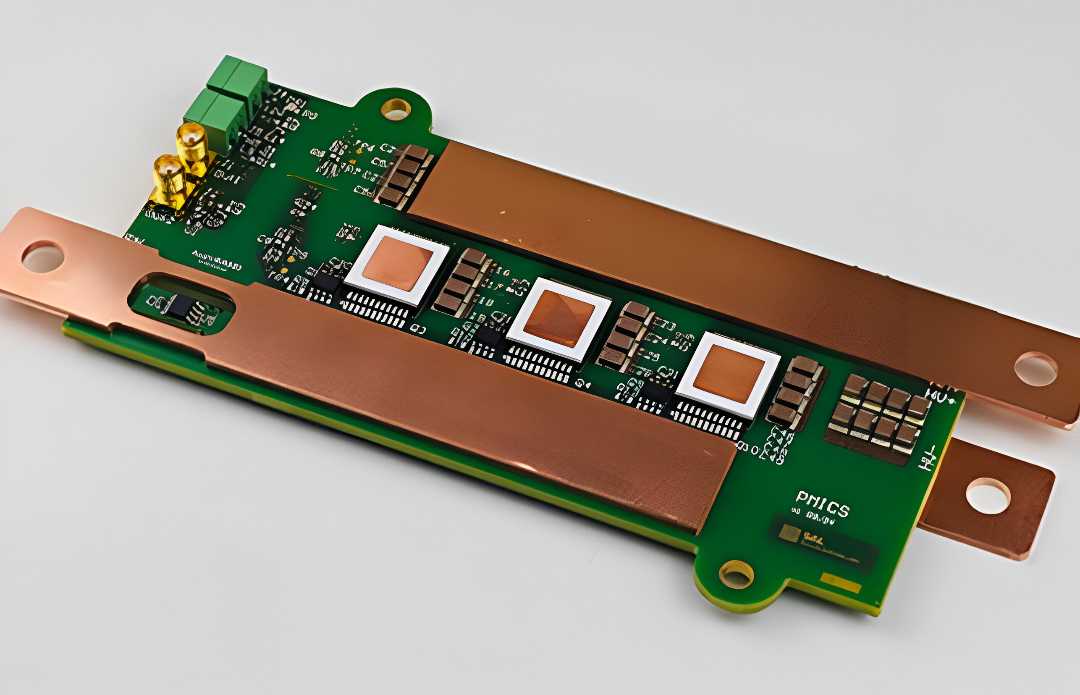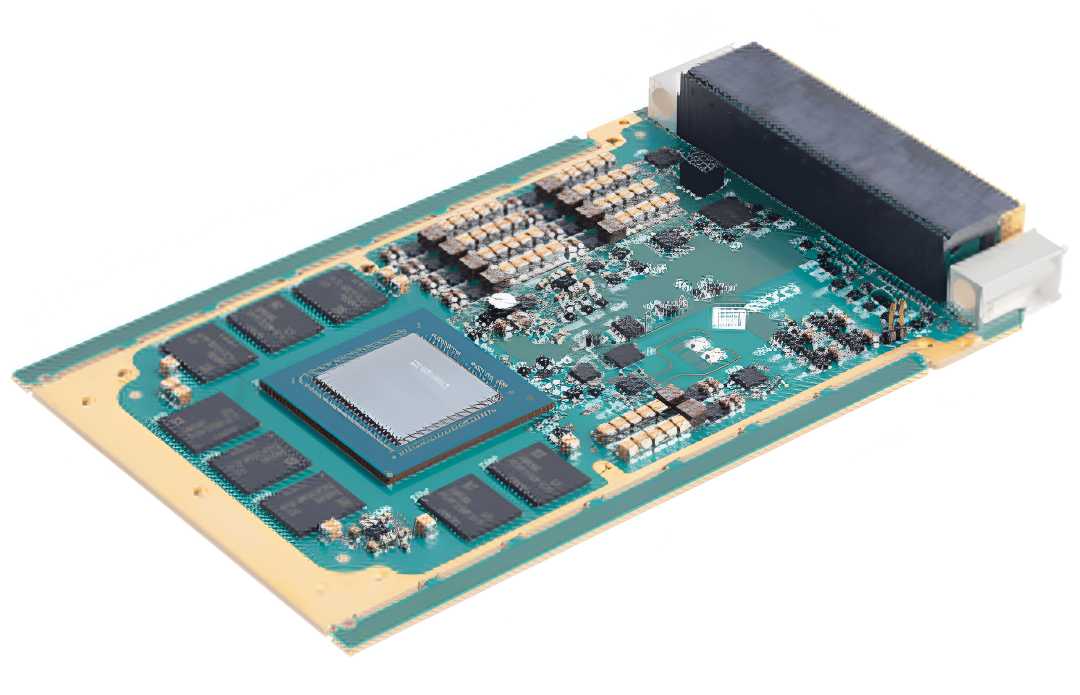Top electronics news: EV sensors, military AI and Wi-Fi 7 | May 6 - May 9
Welcome to the EOVLOG weekly update!
Do you have only 5 minutes? Perfect, because this article is ideal for catching up on the latest developments and trends in the world of electronic engineering and telecommunications. We offer you a clear, direct and easy-to-read summary, with the most relevant information so you can stay ahead of the curve without wasting time. 🧠 Enjoy this quick dose of knowledge and keep your knowledge up to date with the latest in technology.
Table of contents
- Revolution in current sensors: AKM and SAL integrate coreless technology into power modules for electric vehicles.
- GRA117S with NVIDIA RTX 5000: Military power for AI and deep learning in extreme environments
- Wi-Fi 7: Efficiency and low latency redefine enterprise connectivity
-
Size and weight reduction: The elimination of the magnetic core allows the design of more compact and lighter power modules, facilitating their integration in small spaces inside vehicles.
-
High resolution and accuracy: The EZ232L provides accurate measurements even at high currents, improving the operating efficiency of the vehicle’s electrical systems.
-
Improved energy efficiency: Accurate current sensing contributes to more efficient energy management, extending vehicle range and reducing energy consumption.
-
Compatibility with SiC power devices: The technology is especially suitable for silicon carbide (SiC) devices, which are known for their high efficiency and ability to operate at high temperatures and voltages.
-
Data processing in unmanned aerial vehicles (UAVs)
-
Real-time surveillance and reconnaissance systems
-
Image and signal analysis in hostile environments
-
Tactical decision support through AI on the battlefield
News 1: Revolution in AKM and SAL current sensors integrating coreless technology into electric vehicle power modules
🗓️ Date: Tuesday, May 6, 2025
🔗 Link: electronicsweekly.com
Summary: Asahi Kasei Microdevices (AKM) and Silicon Austria Labs (SAL) have developed an innovative technology that integrates coreless current sensors directly into power modules. This solution promises to improve energy efficiency and reduce the size and weight of systems in electric vehicles, marking a significant breakthrough in automotive electronics engineering.
Innovation in current sensors for electric vehicles
AKM and SAL current sensors

Link: automotiveintecnology.com
The growing demand for electric vehicles (EVs) has driven the need for more efficient and compact systems. In response, AKM and SAL have collaborated to develop a proof-of-concept that integrates coreless current sensors into power modules, specifically traction inverters and DC-DC converters. This integration enables high-resolution current sensing, essential for optimizing EV performance and energy efficiency.
AKM’s EZ232L sensor, based on coreless Hall technology, is the central component of this innovation. Unlike traditional sensors using magnetic cores, the EZ232L offers a more compact and lightweight structure, without compromising accuracy in measuring high currents. This is especially beneficial for applications that require a wide current sensing range, such as traction inverters in electric vehicles.
Key benefits of coreless technology
💡 Did you know...
Coreless current sensors, such as the EZ232L, not only reduce system size and weight, but also improve dynamic response and electrical noise immunity, critical factors in demanding automotive applications.
¡Remember this!
Integrating coreless current sensors into power modules not only optimizes the design and efficiency of electric vehicles, but also represents a step towards more sustainable systems that are adaptable to the future demands of the automotive sector. EOVLOG
The collaboration between AKM and SAL on the development of coreless current sensors integrated into power modules represents a significant breakthrough in electronic engineering applied to electric vehicles. This innovation not only improves the efficiency and performance of automotive systems, but also paves the way towards more sustainable and future-proof solutions.
📖 Technical Glossary
Core-less current sensor: A device that measures electric current without using a magnetic core, allowing for more compact and lighter designs.
Hall technology: Physical principle that allows magnetic fields to be detected and, therefore, electrical currents to be measured by specific sensors.
**Traction inverter: A component that converts direct current from the battery into alternating current to power a vehicle’s electric motor.
DC-DC converter: Device that transforms DC voltage levels, allowing powering different systems inside the vehicle.
SiC power devices: Electronic components made of silicon carbide, known for their high efficiency and ability to operate in extreme conditions.
News 2: GRA117S with NVIDIA RTX 5000 as Military Power for AI and deep learning in extreme environments.
🗓️ Date: Wednesday, May 7, 2025
🔗 Source: electronicsweekly.com
Summary: The GRA117S card, powered by the NVIDIA RTX 5000 GPU with Ada Lovelace architecture, redefines graphics processing in military and aerospace applications, delivering exceptional performance in artificial intelligence and deep learning.
Innovation in graphics processing for critical applications
Card GRA117S

Link: sarsen.net
The GRA117S, developed by Abaco Systems, incorporates the powerful NVIDIA RTX 5000 GPU, based on the Ada Lovelace architecture. This combination provides advanced capabilities for applications that require intensive processing, such as artificial intelligence (AI), deep learning, and real-time data analysis.
With 9,728 CUDA cores, 76 RT cores, and 304 Tensor cores, the GRA117S offers exceptional performance in parallel computing and graphics rendering tasks. The GPU features 16 GB of GDDR6 ECC memory, ensuring data integrity in critical environments.
Compatibility with AV1, H.265, and H.264 video codecs allows for efficient video encoding and decoding, essential for surveillance and real-time transmission applications.
Robust design and military standards compliance
The GRA117S is designed to meet the SOSA slot profiles 14.6.11 and 14.6.13, ensuring interoperability and modularity in military and aerospace systems. Its PCI Express Gen 4 interface guarantees high data transfer speeds, essential for applications that handle large volumes of information.
Support for Windows and Linux operating systems, along with compatibility with the NVIDIA software stack (CUDA, CUDA-X, OpenCL), facilitates integration into various platforms and development environments.
Applications in demanding environments
The GRA117S is aimed at aerial, land, and maritime applications, including:
💡 Did you know...
NVIDIA’s Ada Lovelace architecture, used in the RTX 5000, delivers up to 4 times the performance in AI tasks compared to previous generations, thanks to its fourth-generation Tensor cores and support for FP8 precision data.
¡Remember this!
The integration of high-performance GPUs into embedded systems enables advanced processing capabilities in environments where space, weight, and durability are critical factors, opening new possibilities in military and aerospace applications. EOVLOG
The GRA117S represents a significant advancement in integrating graphics and AI processing capabilities into embedded systems for critical applications. Its robust design and standards compliance make it an ideal choice for military and aerospace environments that demand high performance and reliability.
📖 Technical Glossary
GPU (Graphics Processing Unit): A specialized processor designed for handling graphics and parallel computations.
CUDA (Compute Unified Device Architecture): NVIDIA’s parallel computing platform that enables the use of the GPU for general-purpose processing.
RT Cores: Dedicated units for real-time ray tracing, enhancing visual quality in rendering.
Tensor Cores: Specialized units for deep learning operations and neural networks.
ECC (Error-Correcting Code): A memory error correction technique that improves data reliability.
SOSA (Sensor Open Systems Architecture): A standard that promotes interoperability and modularity in defense systems.
News 3: Wi-Fi 7 with Efficiency and Low Latency Redefines Business Connectivity
🗓️ Date: Friday, May 9, 2025
🔗 Link: electronicsweekly.com
Summary: Industrial tests of Wi-Fi 7, led by the Wireless Broadband Alliance, reveal significant improvements in efficiency, latency, and performance for next-generation business applications. Technologies such as XR, AI, cloud computing, and IoT benefit from the power of Wi-Fi 7.
Industrial tests of Wi-Fi 7 boost its potential in business applications.
Wifi 7

Link: timestech.net
In a significant advancement for business connectivity, the Wireless Broadband Alliance (WBA) has revealed the results of industrial tests for Wi-Fi 7, conducted in collaboration with tech giants such as AT&T, CommScope (RUCKUS Networks), and Intel. These tests, carried out in real-world scenarios, assessed the performance of Wi-Fi 7 in business environments, highlighting substantial improvements in key areas such as efficiency, performance, and latency.
The main goal of these tests was to analyze how Wi-Fi 7 could optimize cutting-edge business applications, such as extended reality (XR) experiences, artificial intelligence (AI), cloud computing, and industrial Internet of Things (IoT). The results were impressive, showing that Wi-Fi 7 is not only faster but also offers greater stability and handling capacity in dense device environments.
How does Wi-Fi 7 compare to Wi-Fi 6E?
Tests conducted on the 5 GHz and 6 GHz bands clearly showed that Wi-Fi 7 is a significant upgrade compared to its predecessor, Wi-Fi 6E. In particular, Wi-Fi 7 was observed to offer nearly double the performance of Wi-Fi 6E in the 5 GHz band using 40 MHz channels. This speed boost is crucial for businesses that require fast and reliable data transfers, especially those relying on bandwidth-intensive applications such as augmented reality (AR), video conferencing, and automation.
Additionally, in the 6 GHz band, Wi-Fi 7 maintained a sustained performance of over 1 Gbps at distances of up to 40 feet from the access point, with 160 MHz channels. This performance, especially in high-density environments like offices with thousands of connected devices, showcases Wi-Fi 7’s ability to support a large volume of simultaneous connections without sacrificing quality.
Efficiency and low latency: Key factors for the future of networks
One of the most impressive features of Wi-Fi 7 is its low latency. Tests demonstrated that Wi-Fi 7 not only delivers better speed but also significantly reduces latency, which is critical for next-generation business applications. Companies that depend on real-time collaboration, video conferencing, and AI-driven automation can now enjoy a smoother user experience without the frustrating delays that impact time-sensitive applications.
Moreover, Wi-Fi 7 introduces a new multi-link (MLO) functionality, allowing multiple connections to be managed simultaneously, optimizing spectrum usage, and ensuring stable connectivity even under heavy load. This is particularly important for high-density networks, such as those found in business environments, where solutions are needed to handle thousands of connected devices at once.
Compatibility with existing networks and easy transition
While Wi-Fi 7 introduces a range of technical advancements, it also ensures compatibility with older networks. This is crucial for businesses that do not want to undergo a complete infrastructure overhaul. Tests confirmed that Wi-Fi 7 offers significant improvements in 5 GHz networks, which are still used by many legacy devices. This facilitates the transition to the new technology without affecting older devices, providing a smoother and less disruptive upgrade for businesses.
What to expect from Wi-Fi 7 in the future?
The results of these Wi-Fi 7 tests open the door to a new era of business connectivity. With capabilities such as higher spectral efficiency, greater network reliability, and exceptional performance even in high-density conditions, Wi-Fi 7 is poised to revolutionize the way businesses deploy their networks. Applications that rely on high data transfer speeds and low latency, such as industrial automation, smart offices, and immersive AR/VR experiences, will be the first to take advantage of these advancements.
💡 Did you know....
Traditional Wi-Fi networks often suffer from congestion when handling large numbers of devices. Wi-Fi 7 introduces innovative solutions to improve efficiency and reduce this congestion, which is essential in today’s business environment.
¡Remember this!
Wi-Fi 7’s low latency not only enhances video conferencing but is also crucial for automation and real-time collaboration applications, which are essential in sectors such as manufacturing and healthcare. EOVLOG
📖 Technical Glossary
Latency: The time it takes for data to be transmitted from its source to its destination.
MLO (Multilink Operation): A technology that allows the simultaneous use of multiple links to improve network connectivity and efficiency.
XR (Extended Reality): A set of technologies that integrate augmented reality (AR) and virtual reality (VR).
IoT (Internet of Things): A system of devices connected to the internet that can share data with each other.
5 GHz and 6 GHz: Frequency bands used by Wi-Fi to transmit data.
160 MHz Channels: Bandwidth used to improve the speed and efficiency of the network.
High-Density Networks: Networks with a large number of devices connected at the same time.